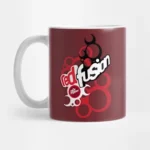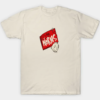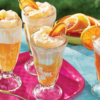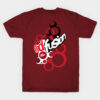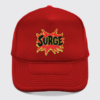Only half of these 26 America born sodas survived

Referred to by some as “liquid candy”, the majority of America (over 50%) refers to soft drinks as “soda.” However, it is certainly not the only term used when referencing those sugary water-based drinks. Folks in the Midwest and Pacific Northwest seem to prefer the term “pop”, while those in the Southern part of the United States like to use the genericized trademark term “coke.” Regardless of what you call it, almost everyone enjoys soft drinks.
Soft drinks actually date back to the medieval Middle East where fruit flavored drinks sweetened with sugar, syrup or honey were widely drank. Soon the popularity of these drinks spread to medieval Europe and beyond.
In 1767, Englishman Joseph Priestley discovered how to make carbonated water (later known as soda water), a defining component to the modern day soft drink. Within a decade after Priestley’s discovery, scientists and inventors throughout Europe improved on his idea, creating equipment that made carbonated water faster and better.
Among those scientists was German born Johann Jacob Schweppe who, capitalizing on Priestly’s experiments, developed a way to manufacture bottled carbonated mineral water. In 1783, he founded the Schweppes Company in the Republic of Geneva to sell his bottled carbonated water.
The following twenty-six brands represent some of America’s oldest, most popular, soft drinks ever created. Some are still with us today, while some have gone off to the big soda store in the sky. Some you may know, and some you may have never heard of.
Schweppes
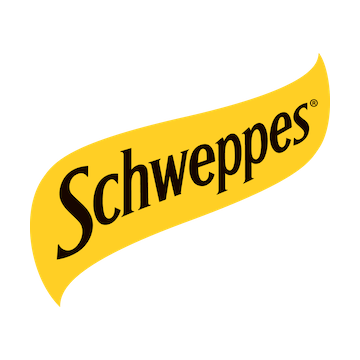 In 1792, nine years after founding his Geneva company, Johann Jacob Schweppe relocated his business to London. In time, his drink caught the eye of Erasmus Darwin, the equally esteemed grandfather of Charles Darwin, who introduced it to his prominent clientele, quickly propelling the popularity of Schweppe’s carbonated drink.
In 1792, nine years after founding his Geneva company, Johann Jacob Schweppe relocated his business to London. In time, his drink caught the eye of Erasmus Darwin, the equally esteemed grandfather of Charles Darwin, who introduced it to his prominent clientele, quickly propelling the popularity of Schweppe’s carbonated drink.
By the turn of the century flavorings, herbs and fruit extracts were added to the carbonated water, the first being ginger. Today Schweppes is recognized as the world’s first and oldest operating soda company. In North America, the Schweppes brand is owned by Keurig Dr Pepper Inc., while in the rest of the world The Coca-Cola Company is its distributor.
Vernors
 While Schweppes is recognized as the world’s oldest soda, Vernors Ginger Ale, and “Woody”, the gnome mascot, enjoys the honor of being America’s oldest surviving soft drink, originating in 1866.
While Schweppes is recognized as the world’s oldest soda, Vernors Ginger Ale, and “Woody”, the gnome mascot, enjoys the honor of being America’s oldest surviving soft drink, originating in 1866.
Pharmacist James Vernor owned a drug store on Woodward Avenue at southwest corner of Clifford Street in Detroit, Michigan where he had a soda fountain offering a variety of flavors, including his own soon to become famous ginger ale. In 1896, Vernor closed his drug store and moved his soda fountain closer to the city center in order to concentrate solely on his ginger ale business.
Vernor died on October 29, 1927 and was succeeded by his son James, Jr., who continued expansion of the business, constructing a new 230,000 square foot bottling plant and headquarters. In the late 1950s, the apostrophe was dropped from the Vernors name, and in 1962 Vernons Zero Sugar was introduced.
In 1966, one-hundred years after it all started, the Vernor family sold the company to s succession of companies. Today it is part of Keurig Dr Pepper.
Hires Root Beer
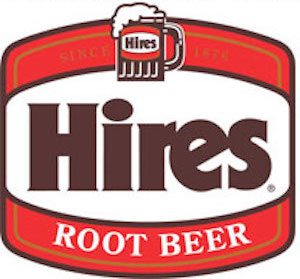 Hires was an American root beer created in Philadelphia, Pennsylvania in 1876 by Charles Elmer Hires. As the story goes, Hires got his first taste of root beer while on his honeymoon in 1875. He was so enthralled with its flavor that he set out to develop his own recipe, and by the next year he had created a powdered mix that yielded one U.S. gallon of root beer. At the 1876 Philadelphia Centennial Exposition Hires sold his root beer for 25-cents a packet, attracting new customers by giving them a free glass of it.
Hires was an American root beer created in Philadelphia, Pennsylvania in 1876 by Charles Elmer Hires. As the story goes, Hires got his first taste of root beer while on his honeymoon in 1875. He was so enthralled with its flavor that he set out to develop his own recipe, and by the next year he had created a powdered mix that yielded one U.S. gallon of root beer. At the 1876 Philadelphia Centennial Exposition Hires sold his root beer for 25-cents a packet, attracting new customers by giving them a free glass of it.
In 1884, Hires began producing a liquid extract/syrup for use in soda fountains. Soon he was shipping root beer in kegs along with a special dispenser he called the “Hires Automatic Munimaker.”
In 1890, he incorporated the Charles E. Hires Company and began producing Hires root beer in small bottles, selling over a million bottles the first year. Hires’ company continued to thrive and by 1960 it was purchased by Consolidated Foods, who sold it two years later to Crush International. After a succession of owners, in 2010 the Hires brand was phased out by Keurig Dr Pepper, in favor of their other root beer brands—A&W in the U.S. and Stewarts in Canada. As of 2023 the Keurig Dr Pepper website no longer lists Hires as one of its brands.
Moxie Cola
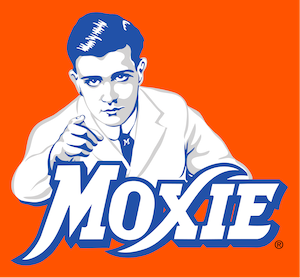 Created in 1876 by Augustin Thompson, Moxie was among the first mass-produced sodas in the United States. Created as a medicinale preparation, Thompson called his beverage “Moxie Nerve Food”, claiming it effective against “paralysis, softening of the brain nervousness, and insomnia.”
Created in 1876 by Augustin Thompson, Moxie was among the first mass-produced sodas in the United States. Created as a medicinale preparation, Thompson called his beverage “Moxie Nerve Food”, claiming it effective against “paralysis, softening of the brain nervousness, and insomnia.”
Thompson’s beverage, with a taste similar to root beer with a bitter after taste, was purported to be named after his friend Lieutenant Moxie, who he claimed had discovered its key ingredient, gentian root extract.
In 1884, Thompson added carbonated water to his formula and began selling Moxie both in bottles and as soda fountain syrup. Marketing it as “a delicious blend of bitter and sweet, a drink to satisfy everyone’s taste”, Moxie became a popular regional drink, especially in the New England states. Thompson died in 1903, but his company lives on. Following a number of ownership changes Moxie was purchased by The Coca-Cola Company on August 28, 2018.
Clicquot Club Sparking Cider Soda
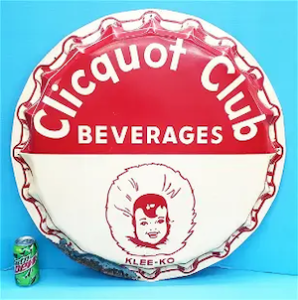 The Clicquot Club Company (pronounced “Klee-ko”) was founded in 1881 by Henry Millis in the small Massachusetts town by the same name. The company’s first beverage was a sparkling cider, produced from a recipe Henry got from Charles LaCroix, a local fruit farmer. After a few successful years, the sparkling cider was discontinued in favor of a ginger ale made from high-quality ginger and Cuban sugar. Soon the company became one of the country’s largest national beverage companies, with plants in more than 100 cities, producing several other soft drink flavors.
The Clicquot Club Company (pronounced “Klee-ko”) was founded in 1881 by Henry Millis in the small Massachusetts town by the same name. The company’s first beverage was a sparkling cider, produced from a recipe Henry got from Charles LaCroix, a local fruit farmer. After a few successful years, the sparkling cider was discontinued in favor of a ginger ale made from high-quality ginger and Cuban sugar. Soon the company became one of the country’s largest national beverage companies, with plants in more than 100 cities, producing several other soft drink flavors.
The company was responsible for pioneering a number of industry firsts—1893, first to seal its bottles with metal caps; 1934, first to sell 32-ounce bottles; 1938, first to sell beverages in cans (known at that time as “cone-top” cans).
After an 84-year run, in 1965 the Clicquot Club company was bought by Cott Beverage Corporation and eventually dissolved.
Dr Pepper
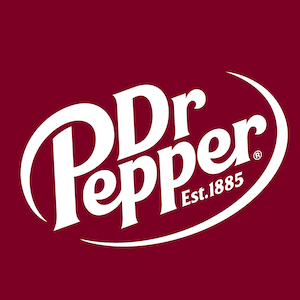 Dr Pepper is a carbonated soft drink created by Waco, Texas pharmacist Charles Alderton in the early 1800s. First sold commercially in 1885 from Morrison’s Old Corner Drug Store (Alderton gave Morrison the recipe), this soda is said to be debatably named after an actual doctor, Charles T. Pepper of Virginia in gratitude to having given Morrison his first job.
Dr Pepper is a carbonated soft drink created by Waco, Texas pharmacist Charles Alderton in the early 1800s. First sold commercially in 1885 from Morrison’s Old Corner Drug Store (Alderton gave Morrison the recipe), this soda is said to be debatably named after an actual doctor, Charles T. Pepper of Virginia in gratitude to having given Morrison his first job.
As with many early soft-drinks, Dr Pepper was said to have medicinal qualities that “aids digestion and restores vim, vigor, and vitality.” Despite persistent rumors, Dr Pepper does not contain prune juice. And while Dr Pepper may look like any other cola, the American FDA has ruled that it is not a cola, not a root beer, nor a fruit-flavored drink. Rather it is in a category of its own, called “pepper soda.”
Dr Pepper, owned and distributed world-wide by Keurig Dr Pepper Inc, is fourth best-selling soft drink in the U.S. and the sixth best seller in the UK.
Coca-Cola
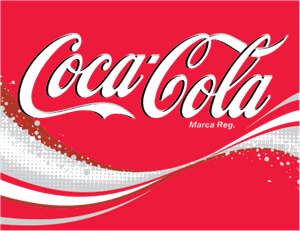 In a quest to find a substitute for morphine, to which he was addicted due to a Civil War wound, John Pemberton registered his formula for Pemberton’s French Wine Coca nerve tonic which contained the African kola nut as the source of caffeine. The year was 1885.
In a quest to find a substitute for morphine, to which he was addicted due to a Civil War wound, John Pemberton registered his formula for Pemberton’s French Wine Coca nerve tonic which contained the African kola nut as the source of caffeine. The year was 1885.
The following year, Fulton County passed prohibition legislation so Pemberton made a nonalcoholic version of his nerve tonic which he marketed as “Coca-Cola: a “temperance drink.” Coca-Cola went on sale May 8, 1886 for 5-cents a glass. Since soda fountains were the all the rage in the late 19th century, Coca-Cola was initially sold as syrup. And like other carbonated drinks at the time Pemberton claimed his formula would cure morphine addition, indigestion, nerve disorders, headaches, and impotence.
In 1888 businessman Asa Griggs Chandler purchased ownership rights from Pemberton for $50 down and a 30-day note for $500. Today, The Coca-Cola Company, based in Atlanta, Georgia, is the sixth most valuable brand in the world, selling 1.8 billion servings a day.
Pepsi-Cola
 In 1893, Caleb Bradham created a carbonated cola flavored soft drink he named “Brad’s Drink.” Sold in his North Carolina drugstore the initial formula included vanilla and sugar and was marketed as a digestive aid and energy booster.
In 1893, Caleb Bradham created a carbonated cola flavored soft drink he named “Brad’s Drink.” Sold in his North Carolina drugstore the initial formula included vanilla and sugar and was marketed as a digestive aid and energy booster.
Renamed Pepsi-Cola in 1898, the brand struggled financially before filing for bankruptcy in 1923. Enter Charles Guth who subsequently purchased and revived the brand by reformulating the syrup. During the Great Depression, Pepsi gained popularity thanks to clever marketing that emphasized value with its 5-cent 12-ounce bottle(double the amount of Coca-Cola sold for 5-cents) and the “Nickel, Nickel” jingle.
Today the band, distributed around the world by PepsiCo, ranks second behind Coca-Cola as the world’s most valuable soft drink brand. The two have a long-standing rivalry known as the “cola wars.”
Koca-Nola Cola
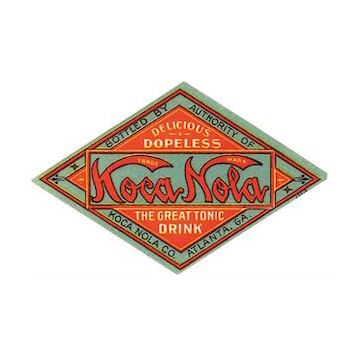 At the turn of the 20th-century, entrepreneur Thomas Austin opened a pharmacy in Atlanta, Georgia. And while the business proved to be a financially sound investment, Austin was unhappy with the lackluster profits contributed by the store's soda fountain. He wanted more. So in 1904 he began to bottle and sell his own beverage under the name Koca-Nola.
At the turn of the 20th-century, entrepreneur Thomas Austin opened a pharmacy in Atlanta, Georgia. And while the business proved to be a financially sound investment, Austin was unhappy with the lackluster profits contributed by the store's soda fountain. He wanted more. So in 1904 he began to bottle and sell his own beverage under the name Koca-Nola.
Austin’s new bottled soda quickly became a resounding success, in part because it looked almost identical to bottles of Coca-Cola (the most popular soda brand at the time), and partially because of his massive marketing efforts. In fact, from 1906 to 1909 Koca-Nola was one of the best-selling soft drinks on the market.
Koca-Nola, like most cola drinks of the day, contained a slight amount (normally about 1/100th of a grain) of the then-legal drug cocaine. And although all soft-drink manufacturers denied it, the U.S. government set out to prove that small amount was enough to make colas addictive to some. Unfortunately, Koca-Nola became the industry’s scapegoat, and sales began to wane, and by 1918 the drink was totally discontinued.
Bubble Up Lemon-Lime Soda
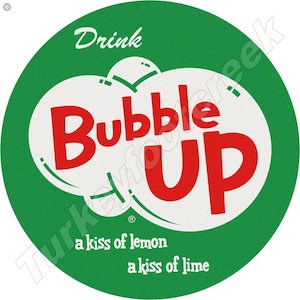 In 1919 the Sweet Valley Products company of Sandusky, Ohio created a lemon-lime soft drink called Bubble Up. Sweet Valley filed the name as a trademark in August of that year with a registration date of April 14, 1921.
In 1919 the Sweet Valley Products company of Sandusky, Ohio created a lemon-lime soft drink called Bubble Up. Sweet Valley filed the name as a trademark in August of that year with a registration date of April 14, 1921.
The name went unused from 1922 to 1937, when LeRoy Schneeburger, president of Whistle-Vest Beverage Company of St. Louis, Missouri, bought the registration and refiled it under his own name. The Bubble Up Company was formed to franchise and bottle the lemon-lime drink across the country.
In 1953 the Bubble Up Company was purchased by the O-So Grape Co. and moved to Peoria, Illinois. Subsequently Bubble Up became part of Hedger Brands and licensed to The Dad’s Root Beer Company, headquartered in Jasper, Indiana.
Nehi
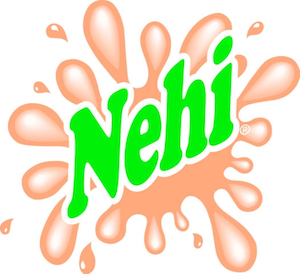 In 1903, businessman/grocer Claud A. Hatcher got into a bitter dispute with his local Coca-Cola representative over the price he was paying for Coke. Hatcher vowed to never buy Coca-Cola again and began to develop his own soft drink formula in the basement of his store.
In 1903, businessman/grocer Claud A. Hatcher got into a bitter dispute with his local Coca-Cola representative over the price he was paying for Coke. Hatcher vowed to never buy Coca-Cola again and began to develop his own soft drink formula in the basement of his store.
In 1905, Hatcher launched the Union Bottling Works from his grocery store with his “Royal Crown Ginger Ale” as its initial soft drink flavor. It was soon followed by strawberry and root beer flavors. Two years later he added a cherry-cola flavor he called Chero-Cola. It quickly became his fastest selling flavor, prompting him to rename his company in 1910, to the Chero-Cola Company.
In 1924, Hatcher developed a new line of fruit flavors calling it “Nehi” (named such to emphasize the products “knee high” tall bottles). His new line of soft drinks quickly became his most successful ever, outselling the entire Chero-Cola line. So, in 1925 the company was once again changed. This time from Chero-Cola to the Nehi Corporation, its shares listed on the New York Curb Exchange (precursor to the NYSE).
Nehi’s sales continued to do well until 1930 when the Great Depression created a million dollar decline in business, ultimately causing the first time the company ever lost money. Claud Hatcher died suddenly on December 31, 1933, and was replaced by H. R. Mott, who had served as vice president for a number of years. Mott immediately restructured Nehi and within a year the company was debt-free and ready to continue its growth.
The company subsequently became part of the Dr Pepper Snapple Group, now known in the U.S. as Keurig Dr Pepper.
Sun Crest Orange Soda
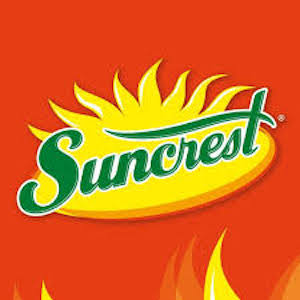 National NuGrape Company of Atlanta, Georgia, introduced the Sun Crest brand in 1938. In 1968 the company and its brands were acquired by The Moxie Company who eventually became Monarch Beverage company. In 2007 Hedinger Brands, LLC. purchased the Sun Crest brand from Monarch, as well as Dad’s Root Beer, Bubble Up, and Dr. Wells. They then licensed Sun Crest to Dad’s Root Beer Company, LLC., with headquarters in Jasper, Indiana. Today, Sun Crest is available only in U.S. markets, both as fountain syrup and in bottles.
National NuGrape Company of Atlanta, Georgia, introduced the Sun Crest brand in 1938. In 1968 the company and its brands were acquired by The Moxie Company who eventually became Monarch Beverage company. In 2007 Hedinger Brands, LLC. purchased the Sun Crest brand from Monarch, as well as Dad’s Root Beer, Bubble Up, and Dr. Wells. They then licensed Sun Crest to Dad’s Root Beer Company, LLC., with headquarters in Jasper, Indiana. Today, Sun Crest is available only in U.S. markets, both as fountain syrup and in bottles.
Grapette “World’s Best Grape Soda”
 In 1926, Arkansas businessman Benjamin Tyndle Fooks purchased a small soft drink bottling plant in Camden. The next year he purchased a second plant in Arkadelphia, Arkansas, and in 1928, a third in New Hope, that he used only as a warehouse. During the Great Depression sales got so bad that Fooks was forced to sell both the Arkadelphia and Hope facilities in order to save his business. During this time, he also traveled throughout Arkansas, Louisiana, and East Texas selling his “Fooks Flavors” out of his car.
In 1926, Arkansas businessman Benjamin Tyndle Fooks purchased a small soft drink bottling plant in Camden. The next year he purchased a second plant in Arkadelphia, Arkansas, and in 1928, a third in New Hope, that he used only as a warehouse. During the Great Depression sales got so bad that Fooks was forced to sell both the Arkadelphia and Hope facilities in order to save his business. During this time, he also traveled throughout Arkansas, Louisiana, and East Texas selling his “Fooks Flavors” out of his car.
After the Depression, in 1932, Fooks hired two salesmen and once again business began to flourish. After reading sales reports that showed customers preference for grape flavored drinks, Fooks began experimenting to develop the “world's best” grape soft drink. In 1939, satisfied with his formula, Fooks traveled to Chicago by rail to purchase the copyrighted Grapette name from Sunset Liquor Company. In Spring of 1940, Grapette officially went on the market where it immediately became one of the top selling national soft drink brands.
In the 1970s, through a series of acquisitions, Grapette U.S. was purchased by its largest rival, NuGrape, who immediately discontinued the brand.
In the early 2000s, Grapette International was able to reacquire the brand and its original formula. Today, Grapette is once again available, distributed exclusively in Walmart stores across the nation.
Fitz’s Root Beer
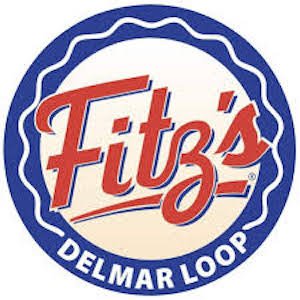 Fitz’s Bottling Company is a regional soft drink brand. Originally a drive-in hamburger joint in St. Louis, Missouri’s Richmond Heights, Fritz’s introduced their homemade root beer in 1947. Its production was suspended in 1976 when the eatery was closed. In 1991, a new restaurant and microbrewery was opened on the Delmar Loop in University City, Missouri, where additional flavors were added.
Fitz’s Bottling Company is a regional soft drink brand. Originally a drive-in hamburger joint in St. Louis, Missouri’s Richmond Heights, Fritz’s introduced their homemade root beer in 1947. Its production was suspended in 1976 when the eatery was closed. In 1991, a new restaurant and microbrewery was opened on the Delmar Loop in University City, Missouri, where additional flavors were added.
Fitz’s now has restaurants and brewing/bottling operations in Chesterfield, Missouri, Kansas City’s Union Station, and South County.
Donald Duck Soda
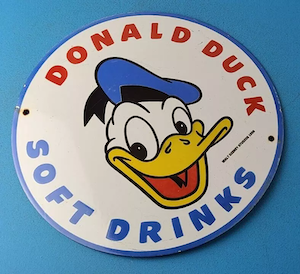 Donald Duck soda line was introduced in 1952 by General Beverages, Inc. of Chattanooga, Tennessee at the American Bottlers of Carbonated Beverages convention. Donald Duck line was made up of these flavors: black cherry, lemon lime, grape, orange, strawberry, ginger ale, root beer, and cream soda. Also included was a cola, said to have been the “improved Pemberton formula.” The soda was first distributed nationwide in both bottles and cone-top cans. Later it also became available in flat punch-top cans.
Donald Duck soda line was introduced in 1952 by General Beverages, Inc. of Chattanooga, Tennessee at the American Bottlers of Carbonated Beverages convention. Donald Duck line was made up of these flavors: black cherry, lemon lime, grape, orange, strawberry, ginger ale, root beer, and cream soda. Also included was a cola, said to have been the “improved Pemberton formula.” The soda was first distributed nationwide in both bottles and cone-top cans. Later it also became available in flat punch-top cans.
Production of the Donald Duck line was, however, short-lived, ending in 1955.
Veep Lemon-Lime Soda
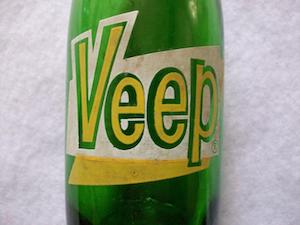 Veep lemon-lime flavored soda was introduced in the mid 1950s by the Coca-Cola Company. As with a number of discontinued Coke products there is very little information available about the brand. Most commonly sold in bottles, cans were introduced shortly before 1964 when Veep was taken off the market, in favor of Sprite.
Veep lemon-lime flavored soda was introduced in the mid 1950s by the Coca-Cola Company. As with a number of discontinued Coke products there is very little information available about the brand. Most commonly sold in bottles, cans were introduced shortly before 1964 when Veep was taken off the market, in favor of Sprite.
Patio Diet Cola
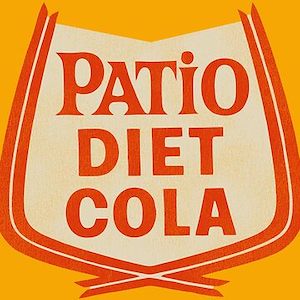 In 1963, PepsiCo introduced Patio Diet Cola in response to RC Cola Company’s Diet Rite Cola. Marketed as an alternative soft drink for those seeking a healthier lifestyle, Patio was also touted as diabetic friendly.
In 1963, PepsiCo introduced Patio Diet Cola in response to RC Cola Company’s Diet Rite Cola. Marketed as an alternative soft drink for those seeking a healthier lifestyle, Patio was also touted as diabetic friendly.
In 1964, Patio release three additional diet flavors—orange, grape, and root beer, in an attempt to round out the line. Later that year the Patio Diet Cola name was dropped, and the drink renamed Diet Pepsi. By the early to mid-1970s the rest the Patio line was phased out and the name retired.
Tab Diet Cola
 Introduced in 1963, Tab was Coca-Cola Company’s first diet drink. Ultimately the Tab line consisted of six flavors—Root Beer, Lemon-Lime, Ginger Ale, Black Cherry, Strawberry, and Orange. In 1983, a caffeine-free version was released as companion to caffeine-free Coke, and in 1992, Tab Clear was introduced, though it never caught on and was discontinued two years later.
Introduced in 1963, Tab was Coca-Cola Company’s first diet drink. Ultimately the Tab line consisted of six flavors—Root Beer, Lemon-Lime, Ginger Ale, Black Cherry, Strawberry, and Orange. In 1983, a caffeine-free version was released as companion to caffeine-free Coke, and in 1992, Tab Clear was introduced, though it never caught on and was discontinued two years later.
In the early 1970s, Saccharin, Tab’s sweetener, was linked to bladder cancer prompting the U.S. Government to mandate warning labels on products containing the sweetener, though later the mandate was repealed.
In 1982, the Coca-Cola Company introduced Diet Coke and with it a decline in Tab sales began. On December 31, 2020, Tab was discontinued, ending its sixty-one-year run.
Worms Cherry Soda
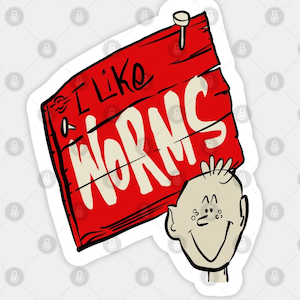 In 1974, two Pepsi employees formed the LADCo (Larry and Duane Company) for the purpose of launching a new soda they called “Worms.” The soft drink became an immediate regional hit, most likely because of its novelty. Unfortunately, Worms success was short lived and by the early 1980s it had disappeared from the market.
In 1974, two Pepsi employees formed the LADCo (Larry and Duane Company) for the purpose of launching a new soda they called “Worms.” The soft drink became an immediate regional hit, most likely because of its novelty. Unfortunately, Worms success was short lived and by the early 1980s it had disappeared from the market.
Aspen Soda
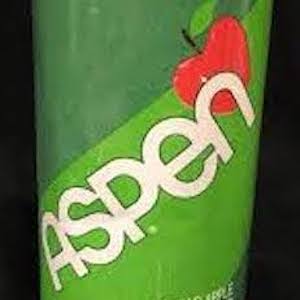 In 1978, PepsiCo introduced the apple-flavored soft drink, Aspen. Sold nationwide with using any number of marketing techniques, this crisp, tangy soft drink failed to take root with the American public and was discontinued just four short years after Pepsi brought it out.
In 1978, PepsiCo introduced the apple-flavored soft drink, Aspen. Sold nationwide with using any number of marketing techniques, this crisp, tangy soft drink failed to take root with the American public and was discontinued just four short years after Pepsi brought it out.
Two years later in 1984, PepsiCo replaced Aspen with another apple-flavored beverage, Slice. And while it lasted longer than Aspen, it too disappeared after just ten years.
Quirst Soda
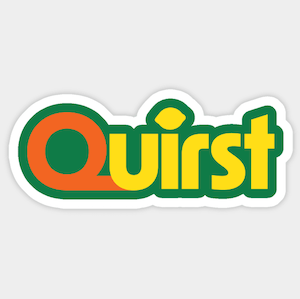 Quirst lemon-lime soda was introduced in 1978 by the 7 Up Company (now a division of Keurig Dr Pepper).
Quirst lemon-lime soda was introduced in 1978 by the 7 Up Company (now a division of Keurig Dr Pepper).
Then in 1980, 7 Up was sued by Squirtco with claims that the name Quirst was too close to the name of their soft drink “Squirt”, and therefore constituted a copyright infringement. It is thought that this lawsuit resulted in taking Quirst off the market after only two years.
Rondo
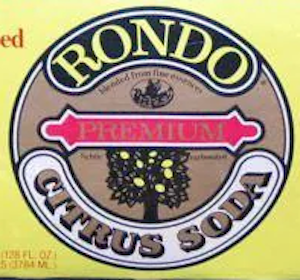 Another citrus-flavored soft drink introduced to the U.S. marketplace, albeit only in limited areas, was Rondo, a 1978 creation of Cadbury-Schweppes. Famous for its advertising slogan “The Thirst Crusher”, Rondo was a lightly carbonated beverage sold in bright yellow cans (Diet Rondo was in green cans). This soda was originally another short-lived product. However, in 2023, Rondo once again returned to grocery shelves in U.S. limited market areas.
Another citrus-flavored soft drink introduced to the U.S. marketplace, albeit only in limited areas, was Rondo, a 1978 creation of Cadbury-Schweppes. Famous for its advertising slogan “The Thirst Crusher”, Rondo was a lightly carbonated beverage sold in bright yellow cans (Diet Rondo was in green cans). This soda was originally another short-lived product. However, in 2023, Rondo once again returned to grocery shelves in U.S. limited market areas.
Mello Yello
 Forty-five years ago in the spring of 1979, the Coca-Cola Company created and released a highly caffeinated (49.5 mg per 12 ounce serving), citrus-flavored soft drink in response to PepsiCo’s Mountain Dew. They named their new soft drink “Mello Yello.”
Forty-five years ago in the spring of 1979, the Coca-Cola Company created and released a highly caffeinated (49.5 mg per 12 ounce serving), citrus-flavored soft drink in response to PepsiCo’s Mountain Dew. They named their new soft drink “Mello Yello.”
There were three short-lived flavor variants of Mello Yello in North America—Cherry, Peach, and Melon, as well as one permanent variant, Cherry.
National bottle/can sales of the Mello Yello brand ended in 2021 and is available today only as a fountain drink in limited markets and various food chains including Arby’s, Hardees, Cracker Barrel, Golden Corral, and Culvers.
Hubba Bubba Soda
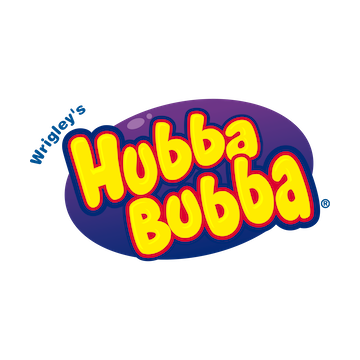 In 1987, a bubble gum flavored novelty soft drink was created and released by Steve Roeder and his partner Larry Wilson. The two operated as the Novelty Beverage Company to produce the drink but used an outside operation to handle packaging and distribution.
In 1987, a bubble gum flavored novelty soft drink was created and released by Steve Roeder and his partner Larry Wilson. The two operated as the Novelty Beverage Company to produce the drink but used an outside operation to handle packaging and distribution.
As the story goes, Roeder created the beverage after tasting a snow cone with bubble gum syrup. The taste of his final formula reminded him so much of Wrigley’s Hubba Bubble gum that he obtained the license to use the name for his soda.
Distribution of Roeder and Wilson’s new soft drink started in Chicago. From there it quickly spread throughout the Midwest and finally across the United States. Unfortunately, as with so many other new soft drinks, sales began to wane as fast as they had grown and the soda was discontinued in 1989.
Crystal Pepsi
 In an effort to meet consumer demand for a light cola soft drink, PepsiCo launched Crystal Pepsi test in the spring of 1992. A 12-ounce serving of Crystal Pepsi contained only 134 calories, which was 20 less than regular Pepsi. By the end of the year their new clear cola went nationwide.
In an effort to meet consumer demand for a light cola soft drink, PepsiCo launched Crystal Pepsi test in the spring of 1992. A 12-ounce serving of Crystal Pepsi contained only 134 calories, which was 20 less than regular Pepsi. By the end of the year their new clear cola went nationwide.
One year and $40 million in marketing later, Crystal Pepsi was discontinued, in spite of being named Best New Product of the Year in 1992.
Sierra Mist Soda
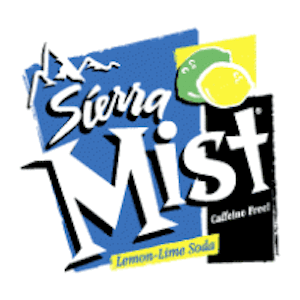 Sierra Mist was a lemon-lime soft drink introduced in 1999 by PepsiCo. The name was a play on its major competitor, Mountain Dew: “Sierra” meaning “mountain range” in Spanish and mist, like dew, is made up of water droplets.
Sierra Mist was a lemon-lime soft drink introduced in 1999 by PepsiCo. The name was a play on its major competitor, Mountain Dew: “Sierra” meaning “mountain range” in Spanish and mist, like dew, is made up of water droplets.
PepsiCo briefly changed the products name to “Mist Test” in 2013, after changing the formula but reverted back to the original recipe and name two years later.
Both regular and diet versions of Sierra Mist were available in a number of flavor variants including cranberry, orange, and grapefruit, before being discontinued in early 2023. PepsiCo replaced Sierra Mist with a new citrus drink called “Starry."
Over the past two centuries, the worldwide marketplace has seen the development of hundreds of soft drink brands. And while many have enjoyed lasting success, many more have come and gone for a number of reasons—poor taste, bad marketing strategies, notoriously fickle consumers. What this article represents are just some of those American born soft drink brands. I hope you’ve enjoyed our walk down memory lane.

